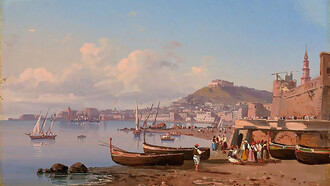As stated in the last article, we have reached our last appointment with San Antonio; this week we will take a look at the religious sites in the city and surroundings. The main churches, or, as the locals refer to, missions, are the San Fernando Cathedral, the Basilica of the National Shrine of the Little Flower, the Mission Concepcion, the Mission San Francisco de la Espada, and the Mission San Juan Capistrano.
San Fernando Cathedral was built in 1731 and is the oldest, constantly working, religious community in the State of Texas; in fact, the church has the added distinction of being the oldest standing church building in Texas for well over 275 years, while still serving the people of the Archdiocese and San Antonio. For almost 90 years, San Fernando Cathedral served as the church for all of the different religious communities and denominations of San Antonio, as the Catholic Church was the only recognized religion of the Spanish and Mexican governments before Texas' independence. San Fernando has become more than the geographic center; it has become an ecumenical, cultural, civic, and service center of San Antonio. However, the church also serves as a refuge for many of the poor in the city of San Antonio that come to this location for help. As the first church in the city, San Fernando has a rich history of responding to the people's needs in and around the church.
San Fernando Cathedral is located in the downtown area; it is a special place that occupies a unique position in this city and for the many visitors who come by the thousands every year. The Cathedral is not just a place of worship for Catholics, but also for all the God-loving people of San Antonio and beyond.
Well over 5,000 people participate at weekend Masses each week of the year; over 900 baptisms, 100 weddings, 100 funerals, and countless other services are performed each year. But San Fernando Cathedral is also a place of entertainment; in fact, symphonies, concerts, and television specials are some of the special events held in the cathedral regularly. Hundreds of people enter the church daily to pray, visit, light a candle, or follow various devotional traditions. Tour buses arrive constantly. Each person is a part of the story of this magnificent place and a tribute to its enduring presence as the spiritual center of San Antonio.
The Basilica of the National Shrine of the Little Flower is the most beautiful church in San Antonio; the place is filled with significant works of fine art such as hand carved Stations of the Cross, a hand carved retable above the central altar, marble altars, and beautiful stained glass. A rose motif is present throughout the church’s fine art. Furthermore, the Basilica of the National Shrine of the Little Flower displays the painting of St. Therese, worked on by her own blood sister, Sr. Celine Martin. This painting was carried in procession to the Vatican on the occasion of the canonization of St. Therese in 1925.
The Mission Concepcion looks exactly as it looked over 200 years ago in 1731. Back then religious festivals were held as friars strove to replace traditional Native American rituals with Christian ideals. What was left of the original wall and ceiling paintings in the surviving rooms of the mission's convento have been conserved; exhibits lead visitors through the grounds and into various quarters set up as they were at the time of the mission's inception.
Mission San Francisco de la Espada looks as remote today as it did in the mid 1700s. It boasts the best preserved segments of the historic acequias, the irrigation system designed to provide water to the crops, part of which includes the still working Espada Dam and Aqueduct. To these days the Espada Aqueduct, still feeds the original mission irrigation system, carrying water from the San Antonio River across Piedras Creek. Espada Dam, built between 1731 and 1740, is the best existing example of the four Franciscan-designed dams and ii is still used today. Collectively these structures are probably the best surviving physical assembly of an 18th century Spanish irrigation network in the United States.
Established along the banks of the San Antonio River in 1731, Mission San Juan Capistrano offered a rich farm and pasture land, becoming a regional supplier of agricultural produce, which helped support the missions, local settlements, and presidio troops. The chapel, with its open bell tower is still in use.
The common factor between all these buildings is that they all have a Spanish influence as they were built by Spaniards, Hispanics, and people of Spanish descendents.
This article concludes our adventure with the city of San Antonio; clearly this is just a little taste of San Antonio, as the city has a lot more to offer to its visitors and inhabitants. As I had the pleasure of living there for over eleven years, San Antonio has become my second home, and will always have a special place in my heart.














